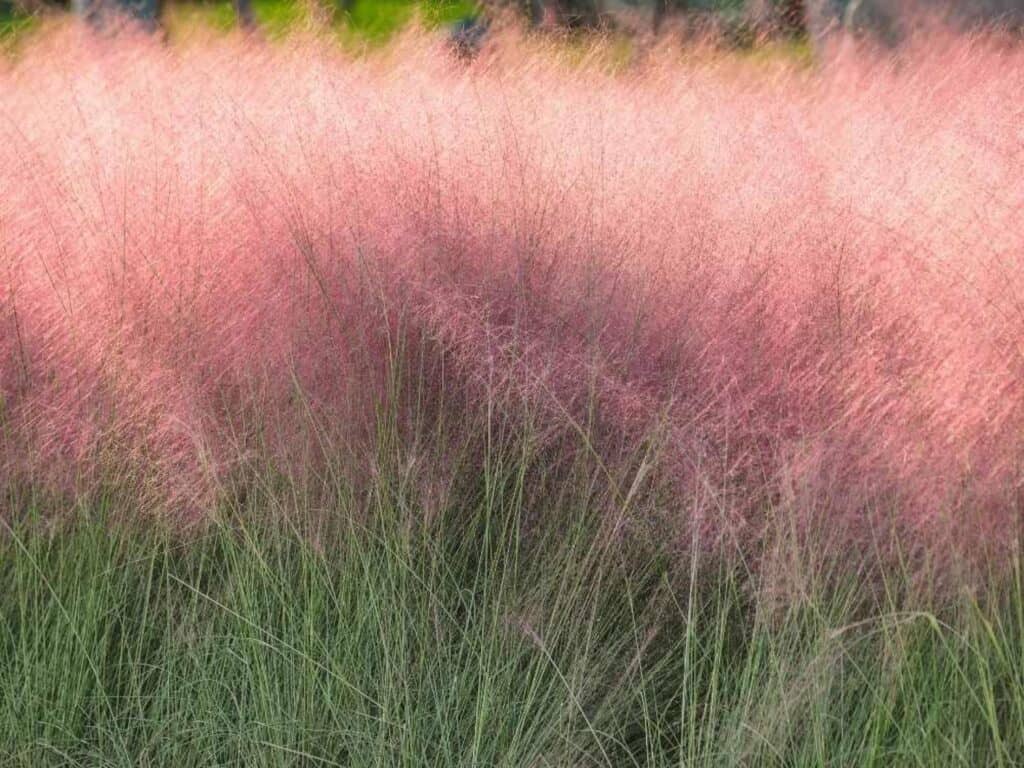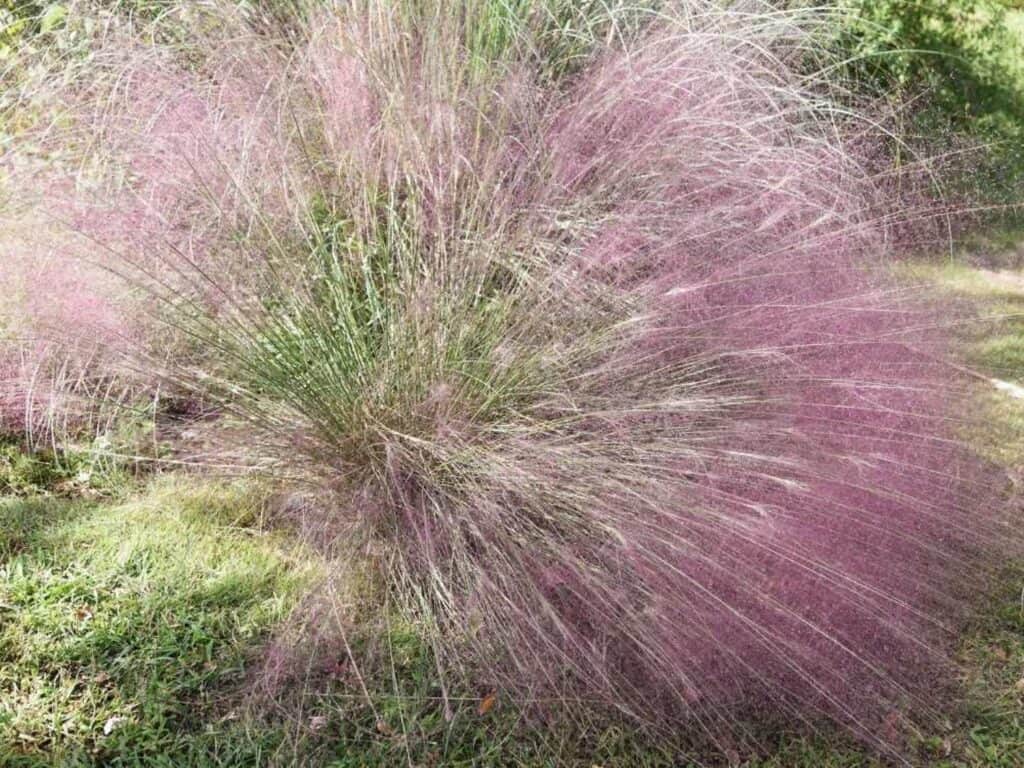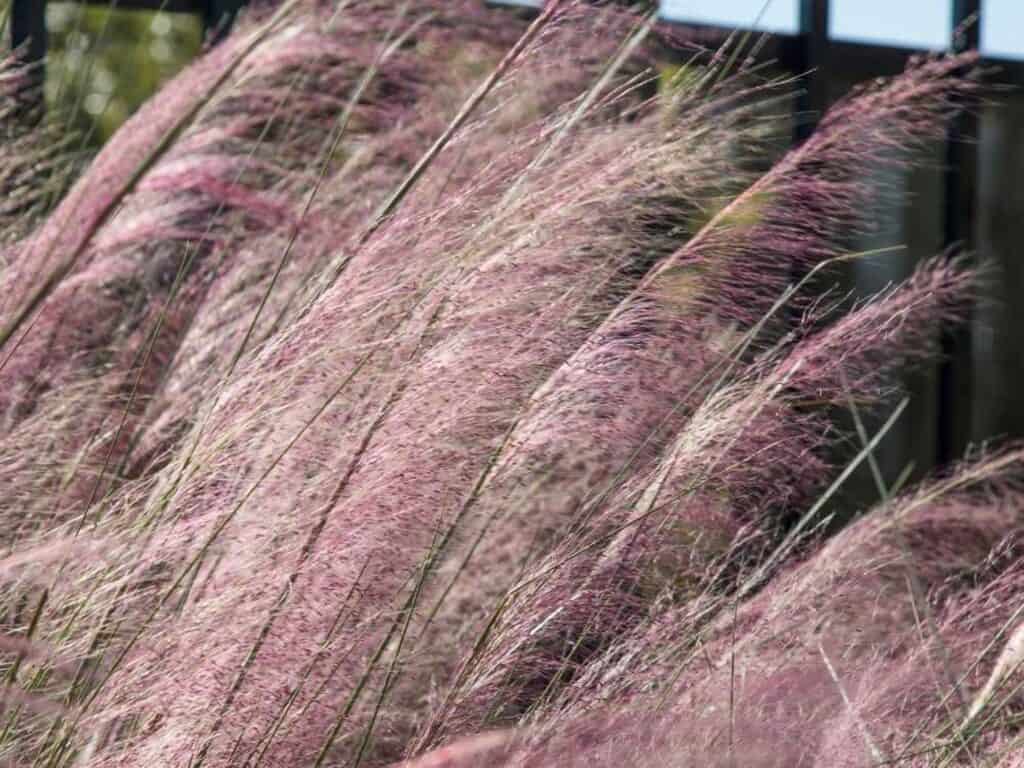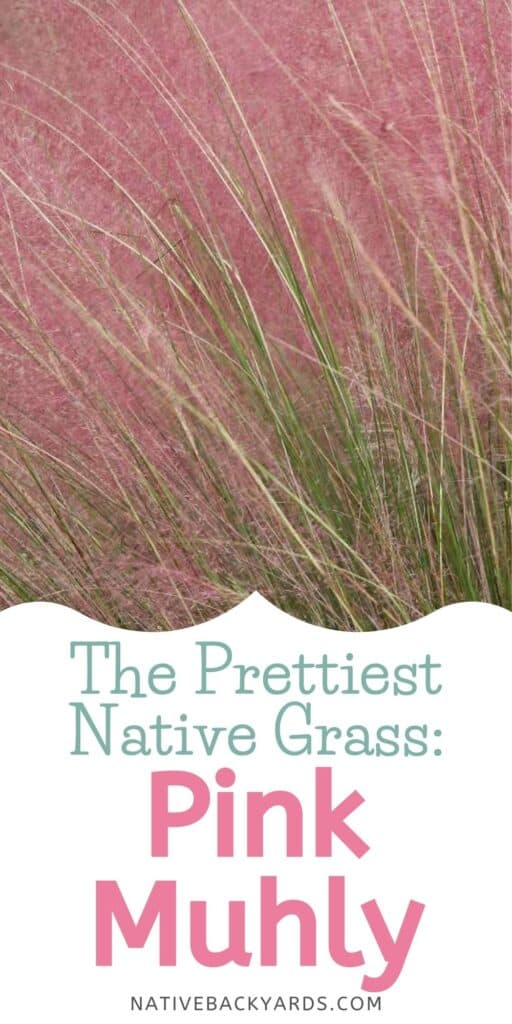Pink Muhly Grass: the Prettiest Native Grass!
If you are looking for a showy ornamental grass that is native to much of the United States, look no further than Pink Muhly Grass (Muhlenbergia capillaris), also known as Gulf Muhly grass.
Ornamental bunch grasses are often underutilized in landscapes, but they can create magic in your garden!

There are lots of beautiful native grasses, but this is the only one I know of that gives the sense of pink fluffy clouds. Even better, this grass puts on a show in October, when other plants in your garden are winding down.
I’I’ve incorporated several Pink Muhly grasses as one of the new plants in my native garden, and I’m counting down the days until Fall!
What does Pink Muhly look like?
Muhlenbergia capillaris is a clumping grass that grows 2-3 feet tall and wide. The grass is green/brown most of the growing season.
Starting in late summer, it turns into a pink fluffy cloud! Its feathery seed heads take up half the plant, giving it an airy feel.

5 Reasons to Grow Pink Muhly Grass
1. Pink Muhly is very easy to grow
This is not a fussy plant as long as you give it sun. It can take part sun and even light shade, but place it in full sun for best results. It can tolerate a variety of soil conditions from dry soil to moist, including poor soils to acidic soils. Although, it performs best in a well-draining soil.
It has good drought tolerance, but does like a little supplemental water in the hottest part of the summer. It’s also deer resistant.
2 It is a more compact alternative to other native prairie grasses
The Big Four prairie grasses (Big Bluestem, Little Bluestem, Indian Grass, and Switchgrass) can grow quite large.
However, Muhlenbergia capillarias is a great choice because it only grows 2-4 feet tall and wide, making it the perfect grass to incorporate into a smaller garden bed. You could also try it in outdoor pots.
3. Its seed heads provide a unique color and texture
I love when I can add unique color to the garden in ways other than blooms. In addition to its striking pinkish purple fall season color, the seed heads provide a cool texture element to the garden.

4. Pink Muhly is a fall showstopper for the garden
Having different seasonal interest is a recipe for a beautiful garden. Incorporating grass plants is an easy way to do this! Pink Muhly looks great interspersed in cottage gardens along with early and late fall flowering plants like these Texas natives:
- Mistflower
- Fall Aster
- Mealy Blue Sage
- Gayfeather
- Coneflower
5. It creates a striking contrast with other garden plants
Pink Muhly is also a good choice for rock gardens to add some fine texture. Pair this soft and airy grass next to plants with sharp edges such as palms and agaves.
For a major statement, try planting Gulf Muhly in mass plantings. It is especially pretty when backlit by the setting sun.
You can also try clipping some of its seed heads and pairing them with cut flowers for pretty indoor arrangements.
What are the other common names for Pink Muhly?
Many times, the same plant can go by a variety of different common names. In addition to the common name Pink Muhly, other common names for this grass include Purple Muhly, Gulf Muhly Cotton Candy Grass. A common cultivar is Regal Mist.
While plants can have many common names, they only have one scientific / botanical name. The scientific name for this grass is Muhlenbergia capillaris.
Where is Muhlenbergia capillarias native to?
Even though one of its common names is Gulf Muhly grass, don’t let that confuse you. This grass is native to a large portion of the United States.
Its native range covers most of the Eastern half of the country to the Midwest, from Massachusetts down to Florida and west to Kansas. It grows well in USDA Zones 6-10. It is typically easy to find at garden centers, especially those that carry native plants.
How do you maintain Muhly Grass?
This perennial plant is a low maintenance grass that prefers full sunlight and well-drained soil. It is an ideal choice for a hands-off gardener. There are a few options for keeping it looking great:
- In late winter or early spring you can rake out the dead stalks and and leaves stuck around the crown of the plant.
- You can trim the grass occasionally to encourage new growth, but you don’t need to cut it back to the ground.
- Try using the “cord technique” to trim the brass by pulling it all into a high “ponytail” and then cutting off the top of the ponytail with a strong set of clippers.
How do you propagate Muhly Grass?
Pink Muhly Grass can be propagated by seed. Wait until after the pink color fades in November to collect the seeds. You can also divide up mature plants.
Common Pink Muhly Questions
Yes! This beautiful grass is a perennial that once planted will provide beauty to your garden for years to come. It takes about three years for Pink Muhly to reach its mature size.
Ideally, yes. Like most ornamental grasses, Muhly grass likes full sun. It can handle part sun or partial shade but may not perform as well.
Muhly grass will lose its pinkish purple color by the end of November and turn straw colored for the remainder of winter. It can still add interest to your garden and shelter for birds and other wildlife over the winter.
No, Muhlenbergia capillaris is not invasive, making it a good selection. It is a clumping grass and does not self-seed readily and therefore does not spread easily.
Pin This to Spread the Word!


Welcome to Native Backyards! I’m Haeley from San Antonio, Texas, and I want to help you grow more native plants.
I have seen firsthand how the right plants can bring your yard to life with butterflies, bees, and birds. I’ve transformed my yard with Texas natives and I’m excited to share what I’ve learned with you.
Join my newsletter here! – each week I’ll send you helpful tips to make your native plant garden a reality!
Want to learn more about me and my garden? Check out my About page!
